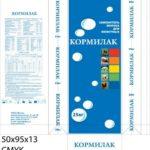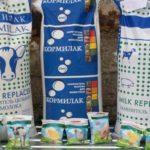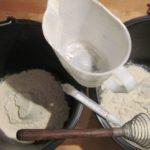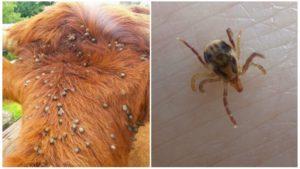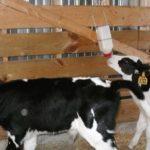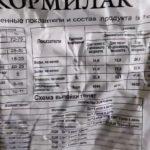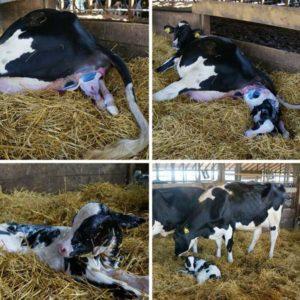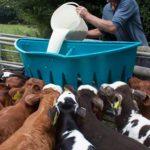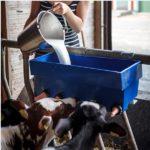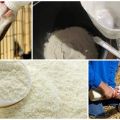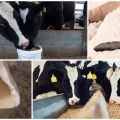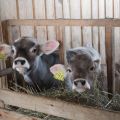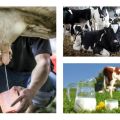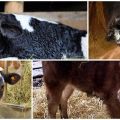Instructions for use and composition of Kormilak for calves, feeding rates
Adequate nutrition is the key to the active growth and development of newborn calves. It is not economically profitable to use whole cow's milk for feeding young animals. The optimal solution is to use the "Kormilak" calf substitute, following the instructions for use. Calves are fed with the mixture from birth to 2.5-3 months. The feed is in demand among livestock breeders, because it is inexpensive and is not inferior in nutritional value to whole milk.
What is milk replacer: what is included
"Kormilak" is created from a mixture of delactose sweet whey, whey protein concentrate and lactose anhydride. Percentage of milk replacer composition:
- 73-75% - dairy products (of which 29-30 - sweet whey, 18-20 - whey protein concentrate, 20-25 - delactose whey);
- 5% - mineral and vitamin supplements;
- 9-10% vegetable protein mixture.
The concentrate, which has a valuable balanced amino acid composition, gives particular value to the product. Membrane technology makes it possible to obtain a concentrate by draining milk whey and "purifying" the product from excess minerals, lactose. Also, delactose whey should not be underestimated as the digestion of newborn calves is able to digest a limited amount of lactose.
Advantages and disadvantages
Many producers offer whole milk replacers for feeding calves. Mixtures are available in different compositions and types (dry powder, concentrated substance, liquid product). Positive qualities of Kormilak milk replacer:
- the mixture does not contain antibiotics;
- the product is enriched with biologically active elements (vitamins, macro- and microelements);
- during the manufacture, easily assimilated milk and vegetable proteins, animal and vegetable fats, synthetic amino acids are used;
- the presence of special emulsifiers prevents the appearance of lumps;
- additives and flavors contribute to increased appetite in calves;
- the shelf life of the feed is 8 months.
The mixture does not show any pronounced flaws. When breeding feed, the proportions indicated by the manufacturer must be strictly observed. Since a violation of the norms can provoke diarrhea in animals.
Types and classification
Firms produce milk replacers according to certain recipes. Depending on the percentage of substances in the product, the powders are intended for feeding calves of a certain age. Several types of "Kormilak" powder are produced according to the percentage of fat and proteins (comparative table).
| Kormilaka view | Percentage of substances | |
| fats | proteins | |
| No. 20 for calves from the 5th day of life | 20 | 22 |
| No. 16 for newborns from the 7th day of life | 16 | 22 |
| No. 12 for animals from the 21st day of life | 12 | 21 |
When choosing a certain type of substitute, its classification (relative to the age of the animals) must be taken into account.
How to choose milk replacer?
To choose a quality substitute for whole milk, several factors must be taken into account: the biochemical composition of the product, the availability of feed for calves of different ages, the type of consistency, and the cost. For animal feeding, manufacturers produce two types of substitutes:
- dry powder and concentrated mixtures (diluted with water in certain proportions);
- liquid feed, ready for immediate use.
Dry feed is most in demand, since products are easier to store and have a long shelf life. A significant plus - the composition of the feed is as close as possible to the quality of cow's milk.
If you focus on the cost of the product, you need to take into account that cheap mixtures differ in poor-quality composition.
Unprocessed soy flour and other low-quality substances are added to the substitutes. These additives can cause diarrhea in animals and are therefore not recommended for feeding calves.
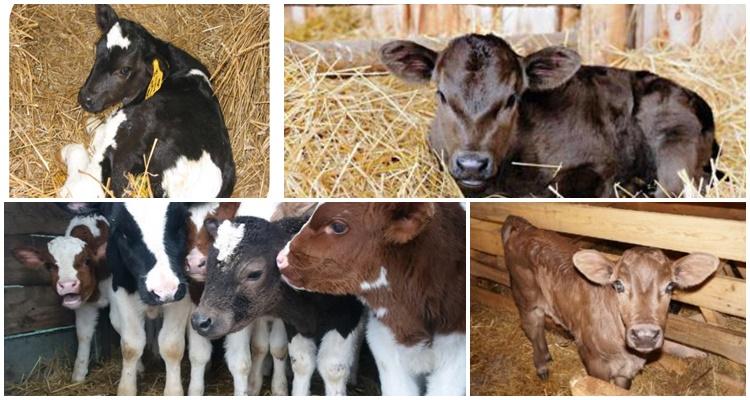
How to dilute dry milk replacer?
A properly prepared milk replacer is better absorbed by the newborn's digestive system. The required part of the powder is first diluted with a small volume of hot water, and then a certain amount of liquid is gradually added so that there are no lumps in the finished mixture. Powder dilution features:
- the mixture must be fresh, so it is prepared just before feeding the animals. The finished product must be fed within 8-10 minutes, as sediment forms later and the nutritional value of the whole milk substitute decreases;
- the liquid is poured into cleanly washed containers so as not to provoke diarrhea;
- cold dairy product should not be fed to calves. The mixture should be warm (the optimum temperature is 35-38 ° C).
It is recommended to strictly follow the instructions from the feed manufacturer. As a rule, there should be at least 12% in the finished solution of dry powder.
Drinking norms
On average, during the growth process, the calf eats 38-40 kg of whole milk substitute powder before switching to the adult diet. Since the daily requirement of an animal (2 to 12 weeks old) in a dairy product is 6-7 liters, about a kilogram of powder is used to prepare the mixture.
As they grow older, after about a month and a half, calves begin to feed a smaller amount of milk replacer, since complementary foods (hay, silage, vegetables, compound feed) are gradually introduced into the diet.
In the first months of life, the calf's body develops most actively. For full growth, an animal needs sufficient amounts of both proteins, fats, carbohydrates, and vitamins, microelements. Dry food "Kormilak" is a high-quality and cost-effective substitute for cow's milk.
